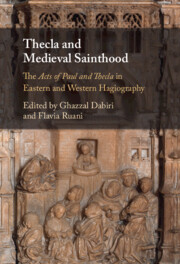Book contents
- Thecla and Medieval Sainthood
- Thecla and Medieval Sainthood
- Copyright page
- Contents
- Contributors
- Acknowledgments
- Abbreviations
- Introduction
- Part I An Act to Follow
- Part II An Act to Surpass
- Chapter 7 Thecla, the First Cross-Dresser?
- Chapter 8 From Diotima to Thecla and Beyond
- Chapter 9 Reception and Rejection
- Chapter 10 A Medieval Sufi Thecla?
- Afterword
- Appendix Summaries of Texts
- Index
- References
Chapter 7 - Thecla, the First Cross-Dresser?
The Acts of Paul and Thecla and the Lives of Byzantine Transvestite Saints
from Part II - An Act to Surpass
Published online by Cambridge University Press: 06 May 2022
- Thecla and Medieval Sainthood
- Thecla and Medieval Sainthood
- Copyright page
- Contents
- Contributors
- Acknowledgments
- Abbreviations
- Introduction
- Part I An Act to Follow
- Part II An Act to Surpass
- Chapter 7 Thecla, the First Cross-Dresser?
- Chapter 8 From Diotima to Thecla and Beyond
- Chapter 9 Reception and Rejection
- Chapter 10 A Medieval Sufi Thecla?
- Afterword
- Appendix Summaries of Texts
- Index
- References
Summary
This chapter critically examines two long-held beliefs with regards to Thecla, the first Christian heroine to take on male dress: 1) that she is the forerunner of Byzantine transvestite saints and 2) that her tale is a reference point for their narratives (fourth to seventh centuries). Arguably, these claims are usually based on hasty assumptions or insufficient evidence built on one particular transvestite saint’s Life, the Life and Martyrdom of Eugenia. In this chapter, I discuss Thecla’s literary legacy both in the wider tradition of Greek hagiography and specific cross-dressers’ Lives. I demonstrate that the Life of Eugenia is an exception among cross-dressers’ tales in terms of its frequent referencing and evident modeling of the APT. This point is especially salient considering the APT’s many echoes in certain Greek hagiographies that are not concerned with cross-dressers. Finally, I propose some new perspectives on how the motif of cross-dressing traveled from the APT until it appeared in later hagiographical accounts. I argue that the Acts of Xanthippe and Polyxena, Life and Miracles of Thecla, and Life of Eusebia called Xenê represent important intermediary steps both in the interpretation of Thecla as a cross-dresser and in the development of this literary theme.
Keywords
- Type
- Chapter
- Information
- Thecla and Medieval Sainthood<I>The Acts of Paul and Thecla</I> in Eastern and Western Hagiography, pp. 197 - 232Publisher: Cambridge University PressPrint publication year: 2022



